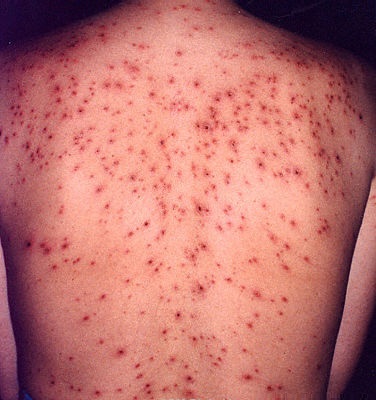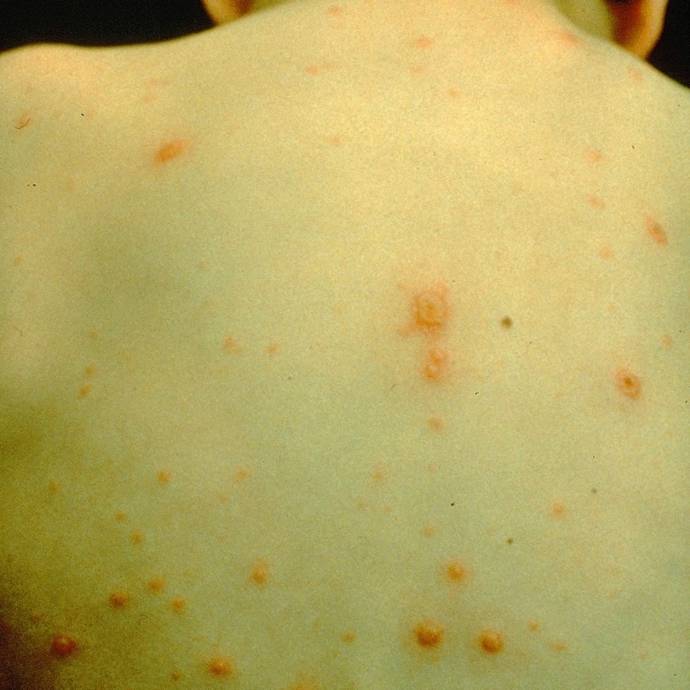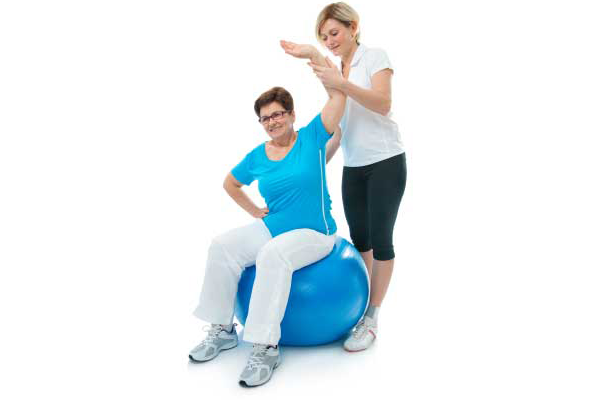Chickenpox is the condition caused by the infection of varicella sister virus. The symptoms of this condition include rashes, blisters, fever, muscle pain, and malaise. The disease is diagnosed through physical examination and viral culture. Complications of the disease include sepsis, pneumonia, and encephalitis.
Types
Chickenpox can be divided on the basis of the severity of the disease. The severity of the disease is evaluated on the basis of the number of blisters, fever and the duration of illness. Chickenpox can be divided into the following two types:
- Mild chickenpox: This type of chicken pox causes very few of no blisters. The patient experiences only red spots on the skin. There is mild fever and the duration of illness is less as compared to severe chickenpox. This type of chickenpox is generally found in those children who have been vaccinated for chickenpox.
- Severe chickenpox: This form has more severe symptoms as compared to mild chickenpox. The patient experiences rashes, which progresses into fluid-filled itchy blisters. Fever is high, and the duration of illness ranges from 7 days to 2 weeks.
Causes
The cause of chickenpox is varicella-zoster virus. The disease is highly contagious and is spread through saliva, coughing, fluid from the blisters of infected person and sneezing. The spread of the disease depends upon the following factors:
- Immunocompromised patients: The person who is immunocompromised are highly prone to chickenpox if they come in contact with the infected person.
- Never infected nor vaccinated: People who are never vaccinated nor get infected with this virus are at high risk due to the absence of any immunity against this virus.
- Children: As the children have immature immunity, thus they are also at higher risk for contracting this disease. Children below the age of 12 years are relatively at higher risk.
- Pregnancy: Pregnant women, due to hormonal changes, are more prone to developing chickenpox.
Symptoms
Following are the symptoms experienced by the patients suffering from chickenpox:
- Rashes
- Itchy and fluid-filled blisters
- Fever
- Headache
- A general feeling of illness
- Loss of appetite
- Muscle pain
- Nausea
- Red and painful skin around the blisters
- Breathing problems
- Feeling irritable
- Stiff neck
Ways to diagnose
Chickenpox is diagnosed on the basis of physical examination and the blood culture report that helps to conclude the presence of the virus.
- Physical examination: Generally the diagnosis can be done by physically examining the blisters as the chickenpox has typically red and fluid-filled blisters which are accompanied by fever. Further, the doctor will also ask various questions about the progression of blisters to confirm the disease.
- Medical history: The doctor may also query about the medical history of the patient and the vaccination history to differentially diagnose the disease. The people with chickenpox vaccination is unlikely to contract the disease.
- Lab tests: Lab tests are done to identify the presence of antibodies in the blood which is formed against the varicella-zoster virus. This will help in analyzing the active chickenpox infection.
- Viral culture: In some cases, viral culture is done to confirm the presence of virus in the body. It is a time-consuming process and till the time results are out, virus completes most of its phases in the body.
Risks if neglect
Although the virus does not cause serious medical disorder when attacks the healthy person but may lead to serious complications in patients such as children, and pregnant women. Following are the complications associated with chickenpox:
- The patient may suffer from sepsis caused due to viral infection in the blood.
- Pregnant women are at high risk in converting chickenpox into pneumonia.
- The disease may spread to the brain causing encephalitis.
- The disease may further spread to the skin causing skin and soft tissue infection.
- The patient may experience severe dehydration.
Stages
Following are the stages of chickenpox:
- Prodromal phase: Begin within 4-5 days after infection, this stage is characterized by the presence of mild symptoms such as mild headache and muscle pain. The virus in this stage spread from the primary site of infection to the lymph nodes.
- Blister stage: In this stage, the virus infects the epidermal layer of the skin and triggers the formation of fluid-filled tiny vesicles.
- Enanthem: Simultaneously with the formation of vesicles, the virus also infects the oral mucosa causing redness and looks like a red ring.
- Early stage rash: Several vesicles combined to form blisters and the infection spreads on whole of the body at a rapid rate. The symptoms of rashes and itchiness are experienced at this stage.

- Formation of pustules: The immune system tries to fight against the infection, resulting in the formation of pus-filled blisters.

- Scarring: The severity of the disease began to start reducing and the vesicles start to be crusted over.

Foods to eat and avoid
Foods to eat:
- Sprouts
- Rice-dal
- Garlic
- Turmeric
- Fresh fruits and juices
- Probiotics
- Yogurt and kefir
- Shiitake mushrooms
Foods to avoid:
- Salty food
- Spicy Food
- High-fat foods
- High carbohydrate food
- Foods with added sugar
Prevention tips
- Get chickenpox vaccination.
- Stay away from the people suffering from chickenpox.
- Follow good hygiene.
- Wear disposable gloves and cover face with a mask if need to meet the infected person.
When to see a doctor
Book appointment with your doctor when:
- The infection spread rapidly.
- The patient is suffering from high fever.
- Rashes are warm and red
- The blisters get infected.
- There are symptoms that concern you.
Do’s & Don’ts
Do’s
- Keep hydrated
- Stay the infected patient from others.
- Take a healthy diet especially proteins.
- Take medicines as prescribed by the doctor.
Don’ts
- Don’t vigorously rub your skin.
- Don’t burst the blisters.
- Don’t take medicines of your own.
- Don’t use any cosmetic on skin without asking your doctor.
Risks for specific people
Children below 12 years, pregnant women, immunocompromised patients, patients on prolonged steroids, patients undergoing chemotherapy, the patient with chronic lung disease, and patients suffering from HIV and cancer are at high risk for developing chickenpox.





